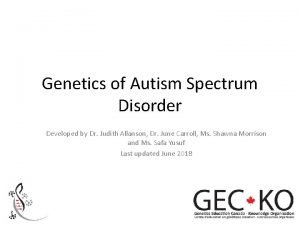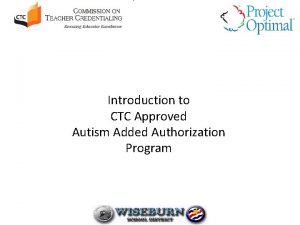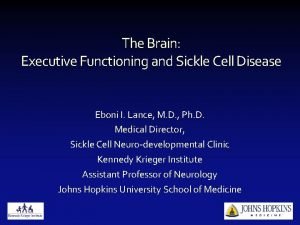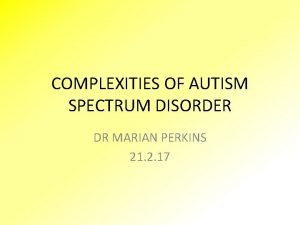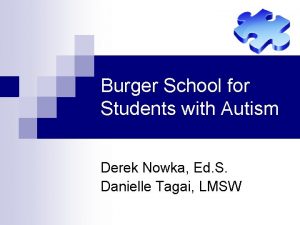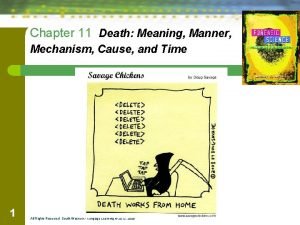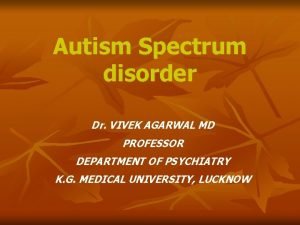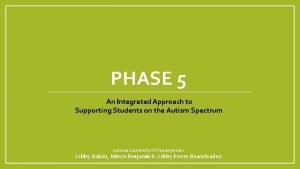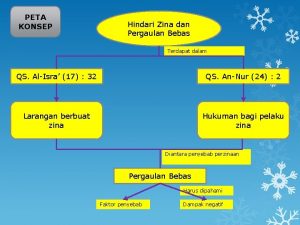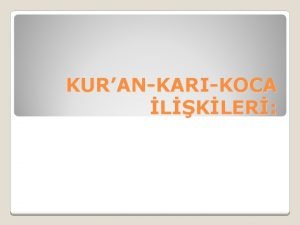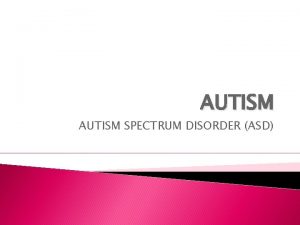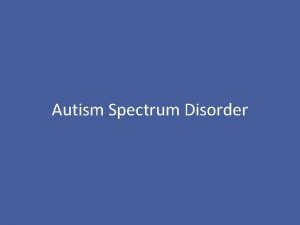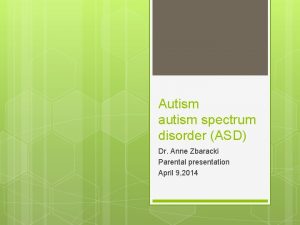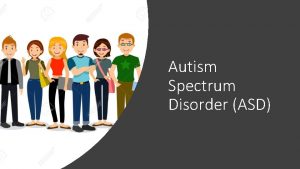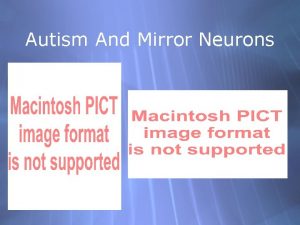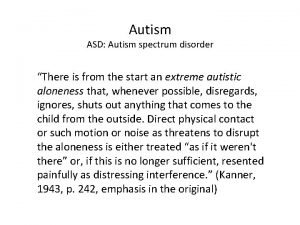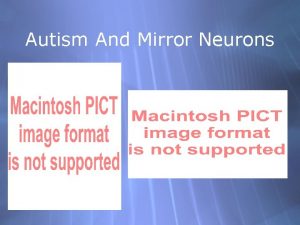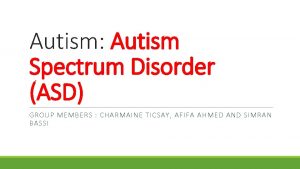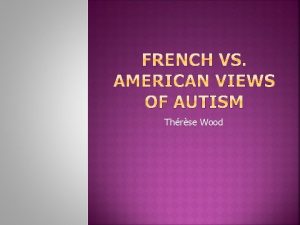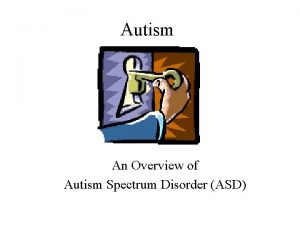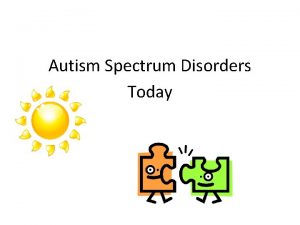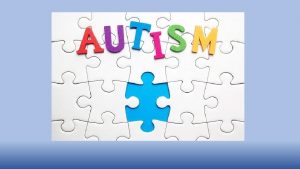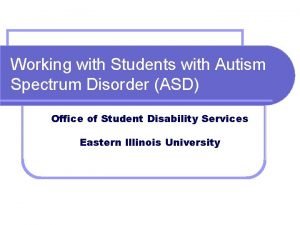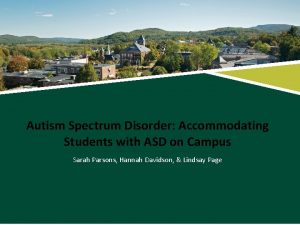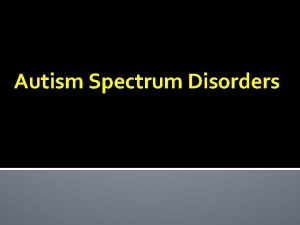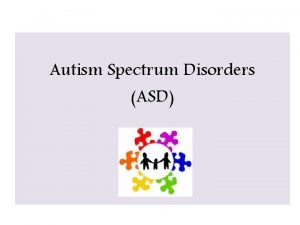Supporting Students with Autism Spectrum Disorder ASD Zina


















- Slides: 18

Supporting Students with Autism Spectrum Disorder (ASD) Zina Boratynec, M. S. , Tina Shaffie, Psy. D. , Kimberly Orliczky, M. A. , BCBA

Today’s Objectives Recognize our students with ASD Understand strengths and limitations of these students on a college campus How to accommodate Behavioral Interventions that may be useful for student success Identify and select campus partners to facilitate referrals for support Student Speakers

What is ASD? A Group of conditions with persistent deficits across multiple contexts: Social Interaction Restricted repetitive behaviors, interests and activities Social Communication Note: Severity of symptoms varies across individuals as does intellectual skills

Social Communication & Social Interaction Deficits in reciprocal social communication and interaction, i. e. knowing how and when to start and end conversations Deficits in non-verbal communication used in social interactions, ex: maintaining eye contact, facial expressions, tone of voice, regulating appreciate social distance. Deficits in skills needed for establishing, maintaining and understanding social relations.

Restricted Repetitive Behaviors, Interests and Activities Stereotyped or repetitive motor movements, use of objects or speech. Examples include hand-flapping, rocking, spinning, finger tapping, flicking or ecolalia. Highly restricted, fixed special interests that often dominate time and conversation. Interests are all consuming, preoccupying, intense in their focus and are typically solitary activities. Insistence on sameness, the propensity to establish and develop rituals and routines that they adhere to rigidly. Difficulty with transitions and change.

Sensory Sensitivities Hyper-reactivity or hypo-reactivity to sensory input. Sights, sounds, smells and tastes may be exaggerated, agitating and even painful. Students may engage in behaviors referred to as “stimming” (repetitive behaviors that reduce the anxiety associated with sensory stimulation) to cope with sensory sensations. Examples include spinning, repetitive finger flicking or fiddling with objects

Recognizing Someone with ASD on Campus Challenges in understanding what you are trying to communicate. Difficulty with eye contact Displays odd, repetitive behaviors, ie. , hand flapping, repeated tapping on the desk, picking skin or biting objects. Asks inappropriate questions, ie. , off topic, personal or interrogating. Appears rude, inflexible, stubborn or impatient, ie. , strange or weird (use intuition). Perseverates over concerns – appears very anxious Does not recognize personal space.

Strengths of ASD Knowledgeable and passionate about their area of interest Efficient employees (will not spend time socializing) Less judgmental – less involved in the social issues Not interested in work politics Very honest Appreciate literal, direct language Unique Strong long term memory Strong visual/special skills Rule followers Detail oriented Strong vocabulary skills

Classroom Behaviors Distracted or Disengaged Difficulty asking for help Unusual behaviors – rocking or tapping Difficulty prioritizing Easily overwhelmed Written language tasks – composition and penmanship Difficulty starting an assignment Worry about turning in substandard work Difficulty seeing others point of view – lack of empathy and insight Transitions – adapting to changes in routines – seating, syllabi Reciprocal social interaction skills Peer interactions and group situations – exclusion and rejection

Transition to Postsecondary Education High school accommodations and IEPs School responsibilities Individualized support Parent involvement Disabled Student Services (DSPS) Student responsibilities Self-determination Advocacy

Partnering with the Parents and Outside Support Services Embrace their knowledge of the student Appreciate their experience and work together to build a bridge to success for the student Assist in connecting them with the DSPS office

Common Accommodations Student must self disclose and provide documentation of disability Accommodations are authorized, based on the documentation provided on a case by case basis: Extension of time/ Separate room Note Taker Record lectures Books in alternative format Adaptive technology Disability-Management Counseling Personal Service Attendant (PSA) DSPS students must meet the same competencies in all courses as all other students. Faculty should never compromise expectations and modifications should not fundamentally alter educational programs or compromise academic standards.

How can faculty and staff help? ? ? Know your student! Reach out for more information when you receive the accommodation form if the student is open to it. “Tell me more about how I can help you? ” Personality style Are they open about their diagnosis or more shy? Are they more verbal or reserved? Sensitivities Are they comfortable being directly addressed in a classroom setting? Are they more anxious? Are they uncomfortable participating?

Support Strategies Set up blackboard: • Provide potential self monitoring opportunities. Timeline for large assignments: • Provided with benchmarks. Such as (due dates for: topic, 1 st draft and final draft). Executive Functioning Syllabus: • Calendar with due dates for Assignments, readings and exams in one place. Note taking support: • Provide copy of the Powerpoint presentation ahead of the lecture. • Assist in securing a volunteer note-taker.

Group Work: • Faculty try to be more observant of the group integration. • Check in with student to see if they have been included. • Hand select the groups. Interruptions/ excessive questions: • Create a visual signal that questions are appropriate at that time for the individual or whole class. • Use self monitoring tools with assistance from the counselors when appropriate (Ex: question cards). Social Interaction Self Care: • Evaluate if hygiene issues have a direct impact on the learning environment. • First, speak to the student, review expectations on classroom etiquette and identify consequences. • If you do not feel comfortable, refer to DSPS for support. Inappropriate social conduct: • Understand the intent of the behavior. The student might be following a literal direction and will not be aware of the violation until directly addressed. • Directly address the inappropriate behavior; why it’s inappropriate, what to do now and what to do next time.

Vocal: • Humming, scripting, thinking out loud, or noises with mouth. • Understand that the student may not be aware of their behavior. • Communicate with them directly and inform them that they are engaging in the behavior and how it affects the class. • Engage student to suggest an alternative solution. Physical: • Tapping, hand flapping, pacing, rocking, picking, or wringing hands. • Allow student to bring in stress ball, silly putty and other manipulatives. Restrictive Repetitive behaviors Ritualistic/ Rigid: • Performing a sequence in order without interruption and requiring sameness in routine. • Be aware that subtle changes in the environment may trigger an outburst. Examples: arrangement of the classroom, seating, schedule of the lesson activities. • Provide space for student to calm down. • Communicate with the student directly and propose alternatives. Transitions: • Physical transition from one activity to the next. • Modifications to the schedule, location or class content. • Consider using a visual schedule or vocal warnings. • Allow students to use a silent phone timer. • Understand that change to routine may be a trigger and allow physical breaks from the room.

Campus Resources and Support DSPS: (949) 582 -4885, SSC 113 Learning Resource Center: 949 -582 -4519 Health Center: (949) 582 -4606, SSC 117 CIT- (949) 582 -4357 General Counseling: (949) 582 -4572, SSC 167 Campus Police- (949) 582 - 4585, lower campus

Student Speakers
 Types of autism
Types of autism Is autism genetic
Is autism genetic Autism authorization ctc
Autism authorization ctc Autism spectrum disorder adhd
Autism spectrum disorder adhd Asd levels
Asd levels Social pragmatic communication disorder vs autism
Social pragmatic communication disorder vs autism Puberty and autism spectrum disorders
Puberty and autism spectrum disorders Factitious disorder
Factitious disorder Burger school for students with autism
Burger school for students with autism Fetal alcohol spectrum disorder
Fetal alcohol spectrum disorder Spectrum disorder
Spectrum disorder Spectrum disorder
Spectrum disorder Line spectrum and continuous spectrum difference
Line spectrum and continuous spectrum difference Absortpion
Absortpion Zina portnova
Zina portnova Zina ayat
Zina ayat Zina portnova
Zina portnova Peta konsep
Peta konsep Zina nedr
Zina nedr

